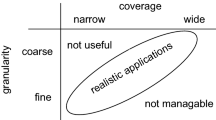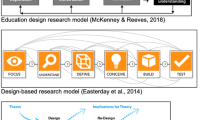Abstract
As the title of this brief implies, there is a process of optimizing a learning object’s reusability. That is, there are rules and procedures that can be applied in a structured yet flexible way. This approach, as with most approaches, provides a structure to the process along with procedural steps that can be looked upon as rules that give the developer a roadmap to follow to give them a reliable means ending in the desired end product. Yet there also exists a fair amount of art in the process as a closer look at the rules reveals that they are in fact rules of thumb. The Merriam-Webster dictionary defines a rule of thumb as “A method of procedure based on experience and common sense” and “A general principle regarded as roughly correct but not intended to be scientifically accurate”. Therefore, judgment and experience play major roles in the process.
You have full access to this open access chapter, Download chapter PDF
Similar content being viewed by others
Keywords
These keywords were added by machine and not by the authors. This process is experimental and the keywords may be updated as the learning algorithm improves.
As the title of this brief implies, there is a process of optimizing a learning object’s reusability . That is, there are rules and procedures that can be applied in a structured yet flexible way. This approach, as with most approaches, provides a structure to the process along with procedural steps that can be looked upon as rules that give the developer a roadmap to follow to give them a reliable means ending in the desired end product. Yet there also exists a fair amount of art in the process as a closer look at the rules reveals that they are in fact rules of thumb. The Merriam-Webster dictionary defines a rule of thumb as “A method of procedure based on experience and common sense” and “A general principle regarded as roughly correct but not intended to be scientifically accurate”. Therefore, judgment and experience play major roles in the process.
As in the sailing/flying learning object example, there are many parameters that the object’s reusability is dependent on. In turn, these parameters are very dependent on the domain at hand. This aspect of custom-made solutions requires that the rules can be at best rules of thumb. However as the first definition implies, as the developer works in various domains they can expect to rely on an increasing amount of experience. This experience together with the rules provides the developer with the ability to develop a degree of true insight into their work as the methodology becomes innate.
Author information
Authors and Affiliations
Rights and permissions
Copyright information
© 2016 Springer International Publishing Switzerland
About this chapter
Cite this chapter
Frantiska, J.J. (2016). Summary/Conclusion. In: Creating Reusable Learning Objects. SpringerBriefs in Educational Communications and Technology. Springer, Cham. https://doi.org/10.1007/978-3-319-32889-8_13
Download citation
DOI: https://doi.org/10.1007/978-3-319-32889-8_13
Published:
Publisher Name: Springer, Cham
Print ISBN: 978-3-319-32888-1
Online ISBN: 978-3-319-32889-8
eBook Packages: EducationEducation (R0)




